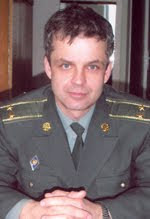Sunday, June 23, 2013
On June 22, 1941 Nazi Germany attacked the Soviet Union marking the beginning of the Great Patriotic War
Posted by Oleg Bezverkhnii at 08:47 0 comments
Tuesday, June 11, 2013
Contract army: is it possible to cancel compulsory military service by 2014?
www.for-ua.com 5 June 2013
Total strength of Ukrainian army will be reduced from 184
thousand to 122 thousand soldiers, press office of the Defense Ministry reports.
Last week the Cabinet approved the army reform state program for 2013-2017,
which provides for the optimization of the army to ensure its combat capability,
which will be achieved primarily by reducing the number of personnel, without
affecting the fighting capacity.
Moreover, the program also foresees
improvement of social protection for militaries and their families, as well
upgrading of equipment and armament. The press office also reminds that the last
conscription will held this autumn, and the last conscript will leave the
service in 2014.

As ForUm wrote in the article "Volunteer army:
inevitable or incredible?", the authorities have been talking about
contract-based army for a long time. Despite permanent lack of finances, the
Armed Forces already have an experience of forming divisions and corps by this
principle. Thus, in 2000 the Armed Forces numbered 28.8 thousand contract
militaries, and in 2004 - 40.7 thousand soldiers. As of February 1, 2013 the
Armed Forces of Ukraine consist of 33% of conscripts and 54% of contract
militaries.
Posted by Oleg Bezverkhnii at 13:06 0 comments
Saturday, May 18, 2013
A holiday of military history in Djuramossa

Most of all, I was impressed with military show. Some pictures taken in the hospitable Djuramossa you can see below. Many participants and spectators were able to by a lot of books and DVDs on military history in SMB book tent. Those who got hungry, got a chance to test a real military pea soup. Even a heavy hailstorm failed to spoil such a nice holiday!

Posted by Oleg Bezverkhnii at 16:31 0 comments
Sunday, March 17, 2013
Special Finnish mission to Poltava
Posted by Oleg Bezverkhnii at 22:08 0 comments
Sunday, December 23, 2012
Adolf Hitler's World War II Eastern Front military headquarters near Vinnitsa (Ukraine)
- 16 July to 30 October 1942.
- 19 February to 13 March 1943.
- 27 August to 15 September 1943.
Posted by Oleg Bezverkhnii at 20:26 0 comments
Labels: Adolf Hitler, Headquarters Werwolf, museum, Ukraine, Vinnitsa, WWII
Thursday, December 6, 2012
Stasi Museum in Leipzig
Posted by Oleg Bezverkhnii at 22:22 0 comments
Saturday, November 17, 2012
Soviet cruise missile AS-5 "Kelt" in Poltava
One such cruise missile is preserving in the Poltava Museum of Long-Range Aviation in the open air, which is located on the territory of the former air base. Museum includes Tu-160 strategic bomber, Tu-95 MS turboprop strategic bomber and rocket carrier, Tu-22 M3 long-range supersonic bomber and rocket carrier with changeable geometry of the wings, Tu-22 KN passenger jet, Su-15 UM fighter, Tu-16 medium-range bomber.
Posted by Oleg Bezverkhnii at 16:51 0 comments









